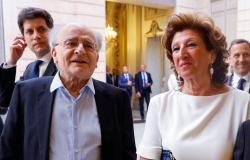Einem snobistischen Bonmot zufolge galt Christie’s in London als Auktionshaus für Gentlemen, die vorgeben, Geschäftsleute zu sein, während Sotheby’s als Anlaufstelle für Geschäftsleute charakterisiert wurde, die Gentlemen sein wollen. Die Pauschalisierung lässt sich, zumal mit Blick auf den gesellschaftlichen Wandel, mit vielen Gegenbeispielen widerlegen. Zutreffender wäre es, besonders auf dem Altmeistermarkt von seit Langem bestehenden, mitunter sogar historischen Loyalitäten zu sprechen. Diese kommen ins Spiel, wenn Kunstwerke wegen persönlicher Umstände – oft Scheidungen, Erbschaftsteuern oder renovierungsbedürftiger Landsitze – veräußert werden. Mal favorisieren die von Unwägbarkeiten des Lebens Eingeholten die eine Firma, mal die andere.
In der Londoner „Art Week“ dieses Sommers ist Christie’s eindeutig im Vorteil. Am 2. Juli wird das Auktionshaus sein stärkstes Altmeisterangebot seit mehr als zehn Jahren aufrufen. Die Einlieferer von zwei Spitzenwerken der Abendversteigerung mit 27 Losen sind denn auch langjährige adelige Kunden.
Fast 150 Jahren in Familienbesitz
Da ist zum einen der Marquess of Bath, der seinen außerordentlich skurrilen Vater vor vier Jahren beerbt hat. Das Treuhändergremium des in eine Stiftung eingebrachten Familiensitzes, Longleat in Wiltshire, trennt sich nach fast 150 Jahren von Tizians „Ruhe auf der Flucht nach Ägypten“. Die intime Szene mit dem in Gedanken versunkenen Josef und der Jungfrau, die den Kopf zärtlich an die Stirn des an ihrem Haar ziehenden Kindes schmiegt, weist den erst knapp zwanzigjährigen Tizian bereits als Meister des venezianischen Kolorits aus. Die Leinwand ist von einer dritten Partei garantiert. Christie’s lässt sich mit einer Schätzung von 15 bis 25 Millionen Pfund einigen Spielraum.
And then there is Viscount Cowdray, who once owned the Financial Times and the Penguin publishing group. From his estate at Cowdray Park in Sussex, which is also held in trust, comes a portrait by Frans Hals dated 1643, which the founder of the considerable family fortune acquired in 1919, with an estimate of four to six million pounds. Based on the coat of arms, which had previously been misinterpreted, recent research has identified the elderly gentleman in the painting as a member of the de Wolff family, who were active in the Haarlem cloth trade and who, like the artist, originally came from Flemish origin.
Now classified as original
Just as touching as the mother-son relationship in Titian’s early work is the Dutch-Leonardesque “Madonna with the Cherries” by the Flemish painter Quentin Massys, which was thought to be lost, at the height of his art. The early appreciation for the picture with the Virgin kissing her child is evidenced by Willem van Haecht’s Kunstkammer painting, which shows, in a dramatically heightened way, the visit of the regent couple of the Spanish Netherlands to the Antwerp spice merchant and collector Cornelis van der Geest in 1615: In the room hung from top to bottom with masterpieces, the host draws the attention of the illustrious group to the Madonna with the Cherries.
The panel painting, which is now being offered as an original, was already auctioned at Christie’s nine years ago. At the time, the experts were deceived by the overpainting and the dark-colored varnish. They thought the painting, which has survived in numerous versions, was a high-quality copy. Valued at up to 80,000 pounds, it brought in 254,500. One wonders how the consignor at the time reacted to the fact that the magnificently restored panel is now valued at up to 12 million pounds by the same auction house.
It is a curious coincidence that both Titian’s early work and the Madonna from the last phase of Massy’s work, which was probably created around 1520, around ten years later, belonged to spice merchants in Venice and Antwerp, whose trophies were coveted by two different governors of the Spanish Netherlands and are also documented in famous Kunstkammer paintings. Archduke Albert and his wife, Infanta Isabella, were unable to persuade van der Geest to sell them the Madonna with the pair of cherries between her pointed fingers.
As the painting by David Teniers in the Prado shows, Archduke Ludwig Wilhelm, who was appointed regent a few years later and whose collection forms the core of the Kunsthistorisches Museum in Vienna, owned Titian’s “Rest on the Flight”. Added to this is the theft by Napoleon and the restitution after the Congress of Vienna, as well as the film-worthy story of the theft of the canvas from Longleat in 1995 – which ended seven years later with it being deposited in a plastic bag at a London bus stop after a ransom was paid.
Rich offer on paper
In comparison, the range of paintings at Sotheby’s seems modest, although there is much of interest. During the day, some excellent works on paper spanning five centuries attract bids, such as a grotesque head and fool’s cap by the Baroque artist Jusepe de Ribera (up to £250,000) and a wonderfully rich pen drawing by Maarten van Heemskeerck of Daniel being lifted from the lion’s den (up to £150,000). In the evening sale of 34 lots, six frescoes by Giandomenico Tiepelo, transferred to canvas, depicting the exploits of the Porto family, stand out. In 2013, they fetched a hammer price of £2.8 million at the auction of the estate of the doctor Gustav Rau. Now they are estimated at up to £2.5 million, a sign of the cautious estimates with which the auction house hopes to lure buyers.
Last year, a customer at Artcurial in Basel paid just under 250,000 francs for an oak panel depicting the Holy Family in a landscape by the Flemish painter Herri met de Bles. Technical examinations and research by Sotheby’s have confirmed the buyer’s suspicion that Rubens had touched up the group of figures in the foreground, as he was wont to do, according to an early biographer, to fuel his genius. The painting has an estimate of 600,000 to 800,000 pounds.






